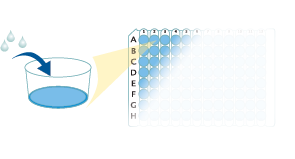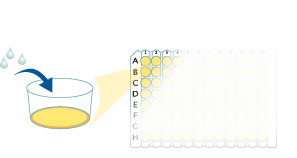Human ENPP-2/Autotaxin Quantikine ELISA Kit Summary
Product Summary
Recovery
The recovery of ENPP-2 spiked to levels throughout the range of the assay was evaluated.
| Sample Type | Average % Recovery | Range % |
|---|---|---|
| Cell Culture Media (n=4) | 102 | 93-109 |
Linearity
Scientific Data
Product Datasheets
Preparation and Storage
Background: ENPP-2/Autotaxin
ENPP-2, also known as Autotaxin, belongs to the ectonucleotide pyrophosphatase/phosphodiesterase (NPP) family. Some NPPs hydrolyze phosphates from nucleotides and their derivatives. ENPP-2 shares 40 - 50% identity to ENPP1 & 3, all of which contain a N-terminal intracellular domain, a single transmembrane domain and a large extracellular domain that includes a catalytic domain, two somatomedin-B-like domains, and a C-terminal nuclease-like domain. Unlike ENPP-1 and ENPP-3, ENPP-2 has weak activity against nucleotides, but exhibits a lysophospholipase D activity which allows the formation of lysophosphatidic acid (LPA) and choline from lysophosphatidylcholine. The hydrolysis of nucleotides and lysophospholipids by ENPP-2 is mediated by a single catalytic site. Evidence shows LPA and sphingosine 1-phosphate to be specific inhibitors of ENPP-2. ENPP-2 was originally found to stimulate tumor cell motility and has since been found to enhance tumor invasion and metastasis and to be up-regulated in several types of carcinomas including breast and lung.
Assay Procedure
Refer to the product- Prepare all reagents, standard dilutions, and samples as directed in the product insert.
- Remove excess microplate strips from the plate frame, return them to the foil pouch containing the desiccant pack, and reseal.
- Add 100 µL of Assay Diluent to each well.
- Add 50 µL of Standard, control, or sample to each well. Cover with a plate sealer, and incubate at room temperature for 2 hours on a horizontal orbital microplate shaker.
- Aspirate each well and wash, repeating the process 3 times for a total of 4 washes.
- Add 200 µL of Conjugate to each well. Cover with a new plate sealer, and incubate at room temperature for 2 hours on the shaker.
- Aspirate and wash 4 times.
- Add 200 µL Substrate Solution to each well. Incubate at room temperature for 30 minutes on the benchtop. PROTECT FROM LIGHT.
- Add 50 µL of Stop Solution to each well. Read at 450 nm within 30 minutes. Set wavelength correction to 540 nm or 570 nm.





Citations for Human ENPP-2/Autotaxin Quantikine ELISA Kit
R&D Systems personnel manually curate a database that contains references using R&D Systems products. The data collected includes not only links to publications in PubMed, but also provides information about sample types, species, and experimental conditions.
6
Citations: Showing 1 - 6
Filter your results:
Filter by:
-
Tumour-specific activation of a tumour-blood transport improves the diagnostic accuracy of blood tumour markers in mice
Authors: Schmithals, C;Kakoschky, B;Denk, D;von Harten, M;Klug, JH;Hintermann, E;Dropmann, A;Hamza, E;Jacomin, AC;Marquardt, JU;Zeuzem, S;Schirmacher, P;Herrmann, E;Christen, U;Vogl, TJ;Waidmann, O;Dooley, S;Finkelmeier, F;Piiper, A;
EBioMedicine
Species: Mouse
Sample Types: Serum
-
Autotaxin secretion is a stromal mechanism of adaptive resistance to TGF? inhibition in pancreatic ductal adenocarcinoma
Authors: Pietrobono, S;Sabbadini, F;Bertolini, M;Mangiameli, D;De Vita, V;Fazzini, F;Lunardi, G;Casalino, S;Scarlato, E;Merz, V;Zecchetto, C;Quinzii, A;Di Conza, G;Lahn, M;Melisi, D;
Cancer research
Species: Human
Sample Types: Plasma
-
Immunometabolic analysis shows a distinct cyto-metabotype in Covid-19 compared to sepsis from other causes
Authors: FM Trovato, S Mujib, E Jerome, A Cavazza, P Morgan, J Smith, MT Depante, K O'Reilly, J Luxton, T Mare, S Napoli, MJ McPhail
Heliyon, 2022-06-24;8(6):e09733.
Species: Human
Sample Types: Plasma
-
Serum autotaxin is a parameter for the severity of liver cirrhosis and overall survival in patients with liver cirrhosis--a prospective cohort study.
Authors: Pleli T, Martin D, Kronenberger B, Brunner F, Koberle V, Grammatikos G, Farnik H, Martinez Y, Finkelmeier F, Labocha S, Ferreiros N, Zeuzem S, Piiper A, Waidmann O
PLoS ONE, 2014-07-25;9(7):e103532.
Species: Human
Sample Types: Serum
-
Serum autotaxin levels correlate with pruritus in patients with atopic dermatitis.
Authors: Nakao, Momoko, Sugaya, Makoto, Suga, Hiraku, Kawaguchi, Makiko, Morimura, Sohshi, Kai, Hiromich, Ohmatsu, Hanako, Fujita, Hideki, Asano, Yoshihid, Tada, Yayoi, Kadono, Takafumi, Sato, Shinichi
J Invest Dermatol, 2014-01-17;134(6):1745-7.
Species: Human
Sample Types: Serum
-
Non-invasive imaging of tumors by monitoring autotaxin activity using an enzyme-activated near-infrared fluorogenic substrate.
Authors: Madan, Damian, Ferguson, Colin G, Lee, Won Yong, Prestwich, Glenn D, Testa, Charles
PLoS ONE, 2013-11-20;8(11):e79065.
Species: Human
Sample Types: Tissue Homogenates
FAQs
No product specific FAQs exist for this product, however you may
View all ELISA FAQsReviews for Human ENPP-2/Autotaxin Quantikine ELISA Kit
Average Rating: 4 (Based on 1 Review)
Have you used Human ENPP-2/Autotaxin Quantikine ELISA Kit?
Submit a review and receive an Amazon gift card.
$25/€18/£15/$25CAN/¥75 Yuan/¥2500 Yen for a review with an image
$10/€7/£6/$10 CAD/¥70 Yuan/¥1110 Yen for a review without an image
Filter by:




